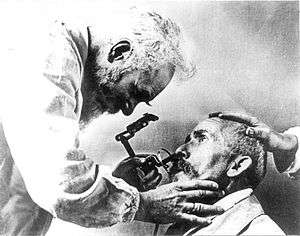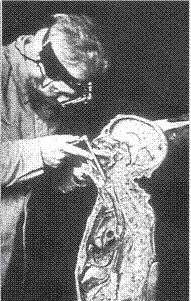Gustav Killian
Gustav Killian (2 June 1860 – 24 February 1921)[1] was a German laryngologist and founder of the bronchoscopy.
.jpg)
Life and death
His father Johann Baptist Caesar Killian (1820–1889),[2][3] the son of a städtischen Wegeaufsehers an urban way overseer,[4] was a doctor of philosophiae and high school teacher born in Mainz and later living in Bensheim. His mother Apollonia (1833–1865), née Höpfel died early, at age 31 of cholera.
He was also born in Mainz, and educated at the University of Freiburg-im-Breisgau. He made revolutionary advances in the diagnosis and treatment of affections of the infralaryngeal passages, especially in the diagnosis and removal of foreign bodies in the bronchial tubes, by means of his new art of bronchoscopic control. His first college appointment was as assistant to Professor Hack of the chair of otolaryngology in Mainz. The sudden death of Wilhelm Hack (1851–1887) led to his succession by Killian, although he was not made professor at the time. His revolutionary activity on bronchoscopy gained him an appointment as professor of laryngology in the University of Berlin; this was the first professorship of such scope in Germany. Killian introduced another innovation known as suspension laryngoscopy into the technic of his specialty. He wrote no monograph on the bronchoscope, and the omission has been supplied by his pupils. His book, Die Schwebelaryngoscopic, appeared in 1920; and in collaboration with Voss was written a volume on military experience, Gehörorgan, Obere Luft und Speisengänge (1921). A Festschrift volume was published around 1920.

Term
Killian's operation -
- Excision of the anterior wall of the frontal sinus, removal of the diseased tissue, and formation of a permanent communication with the nose. -The American Illustrated Medical Dictionary (1938)

Killian's works
- Über die Bursa und Tonsilla pharyngea (1888)
- Die Untersuchung der hinteren Larynxwand (1890)
- Die Nebenhöhlen der Nase in ihren Lagebeziehungen zu den Nachbarorganen (1903). English edition: The Accessory sinuses of the nose and their relations to neighbouring parts (1904)
- Die Schwebelaryngoskopie und ihre praktische Verwertung (1920)
See also
- Killian's dehiscence
- Inokichi Kubo
- This article incorporates text from a publication now in the public domain: Gilman, D. C.; Peck, H. T.; Colby, F. M., eds. (1905). New International Encyclopedia (1st ed.). New York: Dodd, Mead. Missing or empty
|title=(help)
References
- Hans Killian: Gustav Killian, sein Leben, sein Werk, zugleich ein Beitrag zur Geschichte der Bronchologie und Laryngologie. Dustri-Verlag, Remscheid-Lennep 1958
- Werner Kindler: Die Geschichte der Oto-Rhino-Laryngologie in Berlin. Stuttgart, Georg Thieme Verlag 1956
- Peter K. Plinkert: Gustav Killian - Ein Pionier der Endoskopie. In: HNO 46 (1998), S. 629–630
- Notes
- "dictionary of medical eponyms". Whonamedit. 1921-02-24. Retrieved 2016-01-16.
- "Repertorien des hessischen Staatsarchivs Darmstadt. Bestand G18. Zivildiener-Witwenkommission. S.151, online" (PDF). Archived from the original (PDF) on 2015-09-24. Retrieved 2012-11-25.
- "Thorsten Dette, Lutz Schneider: Studentische Disziplin und akademische Gerichtsbarkeit in der 1.Hälfte des 19.Jahrhunderts Namensregister zu den in den Disziplinargerichtsprotokollen der Universität Giessen aufgeführten Studenten GIESSEN UNIVERSITÄTSBIBLIOTHEK (1997) S. 90, online" (PDF). Archived from the original (PDF) on 2018-11-02. Retrieved 2012-11-25.
- Franz Kössler (Hrsg.): Register zu den Matrikeln und Inscriptionsbüchern der Universität Gießen WS 1807/08 - WS 1850. GIESSEN UNIVBRSITÄTSBIBLIOTHEK (1976), S.92, online